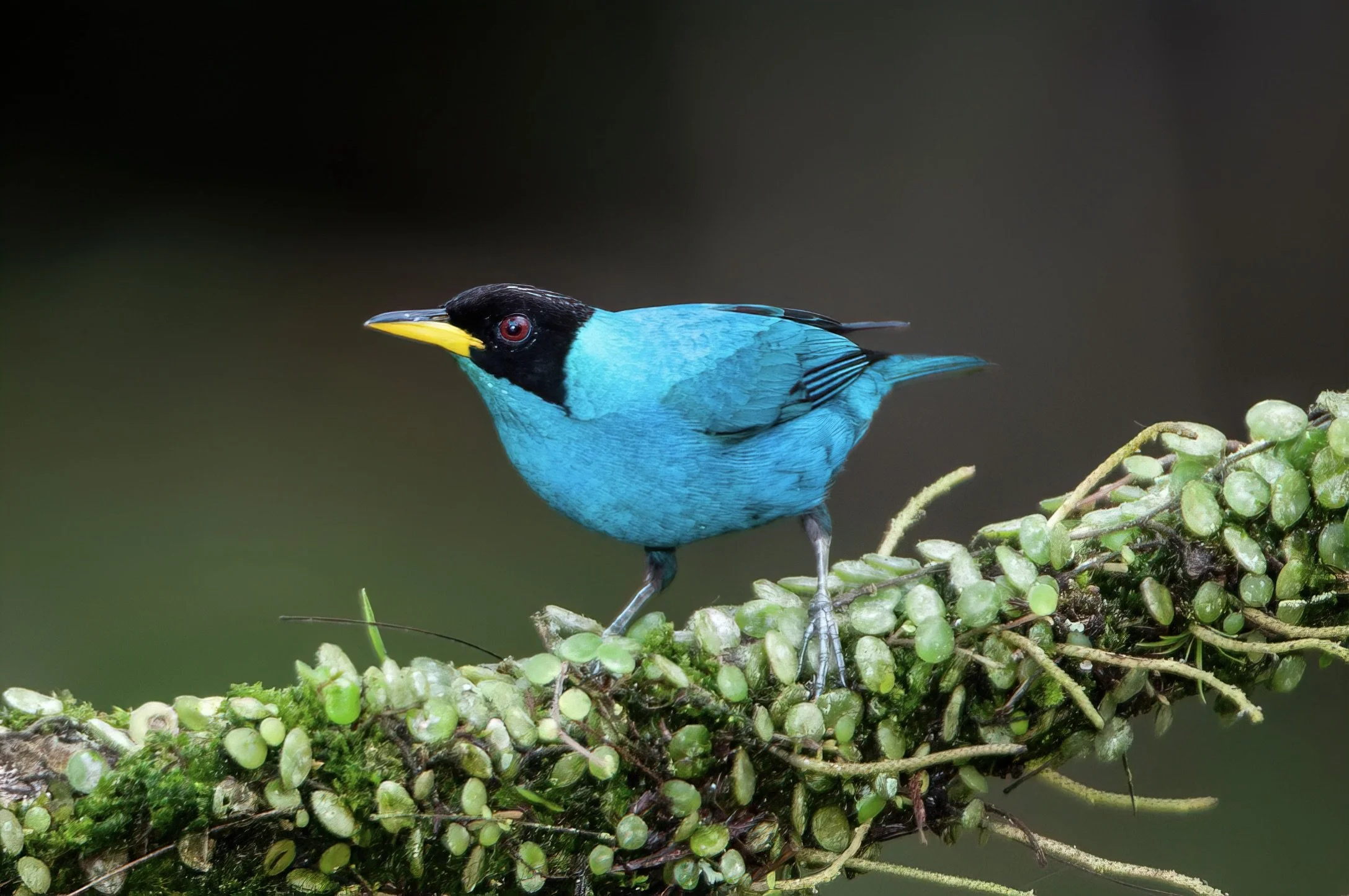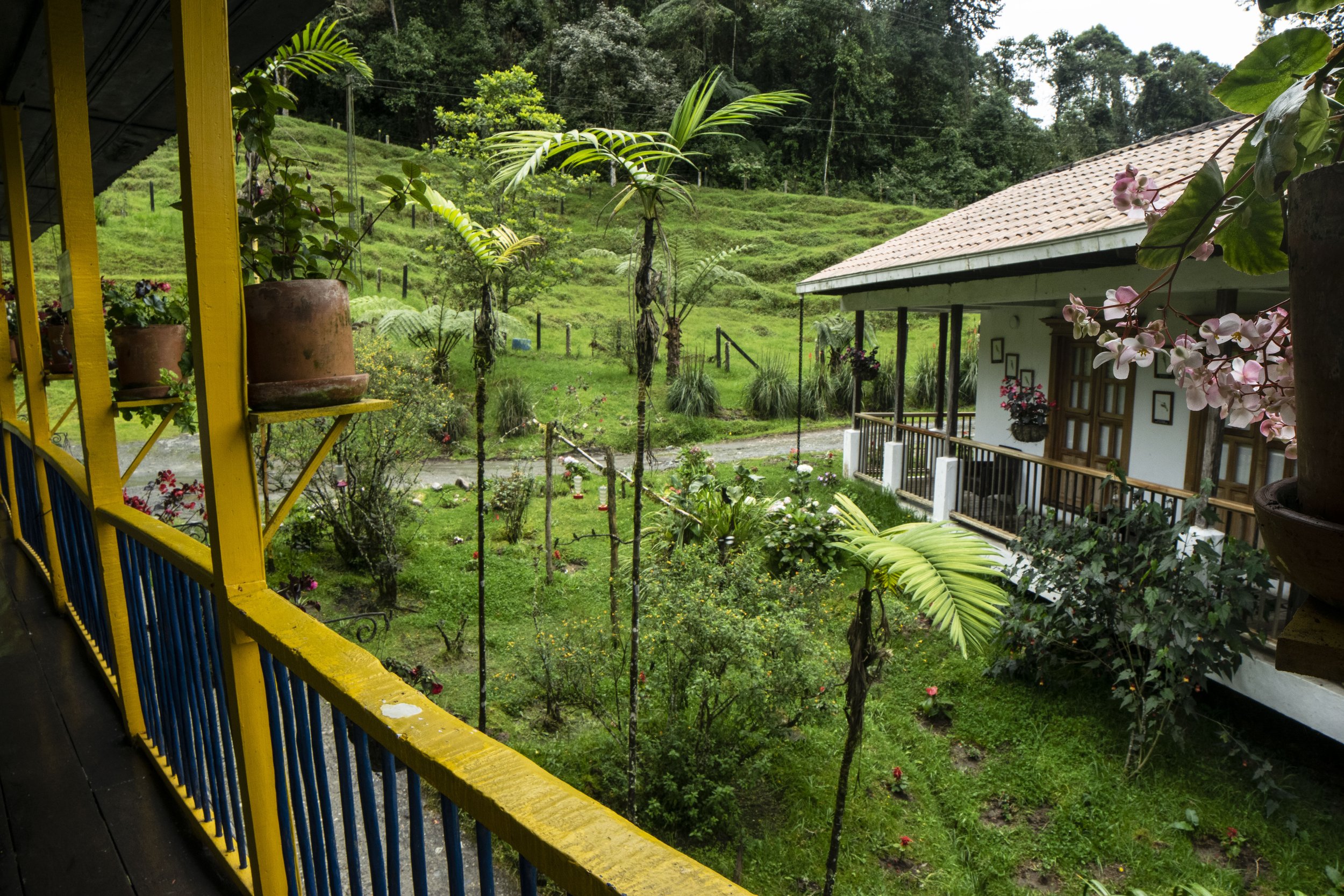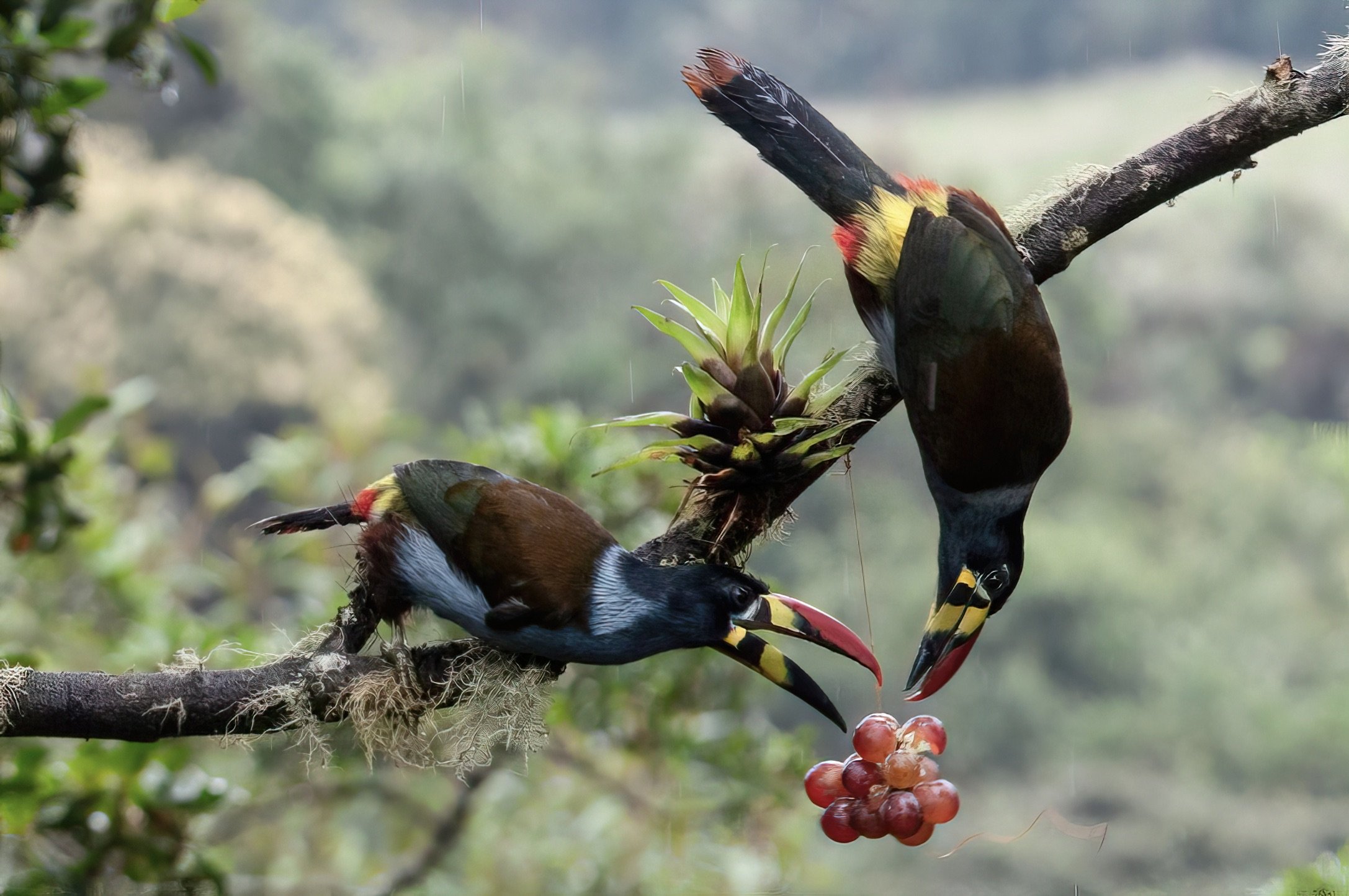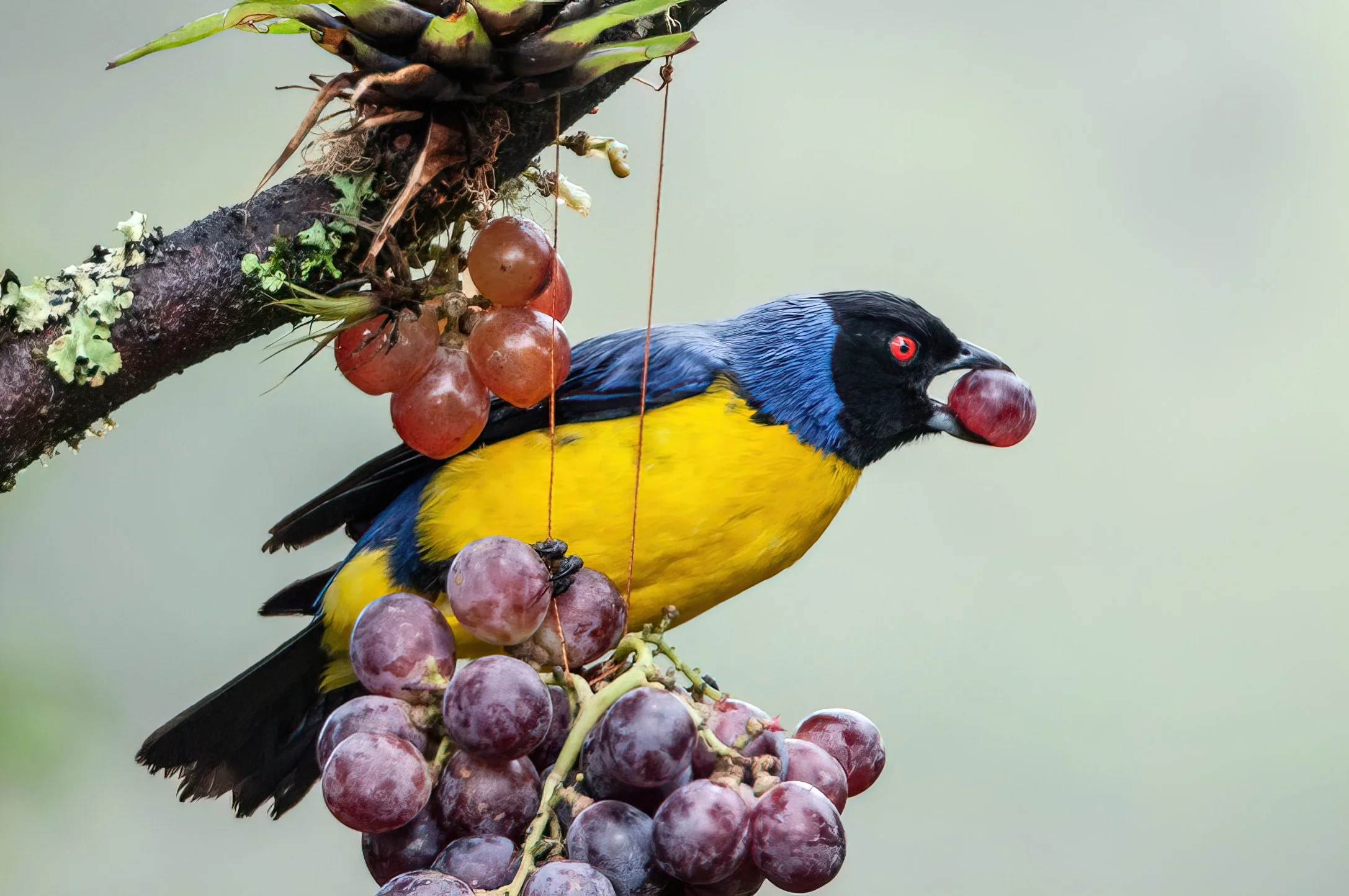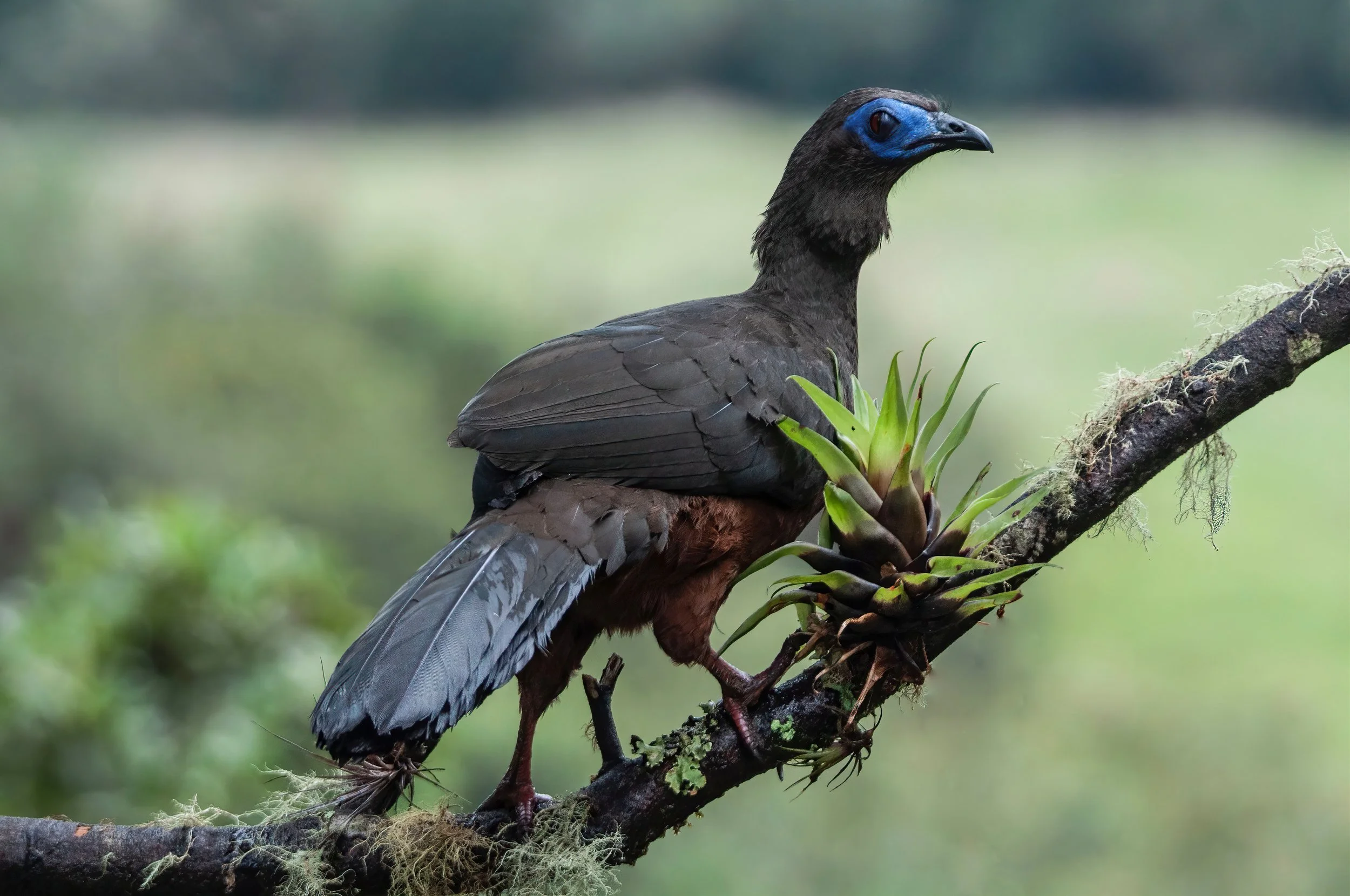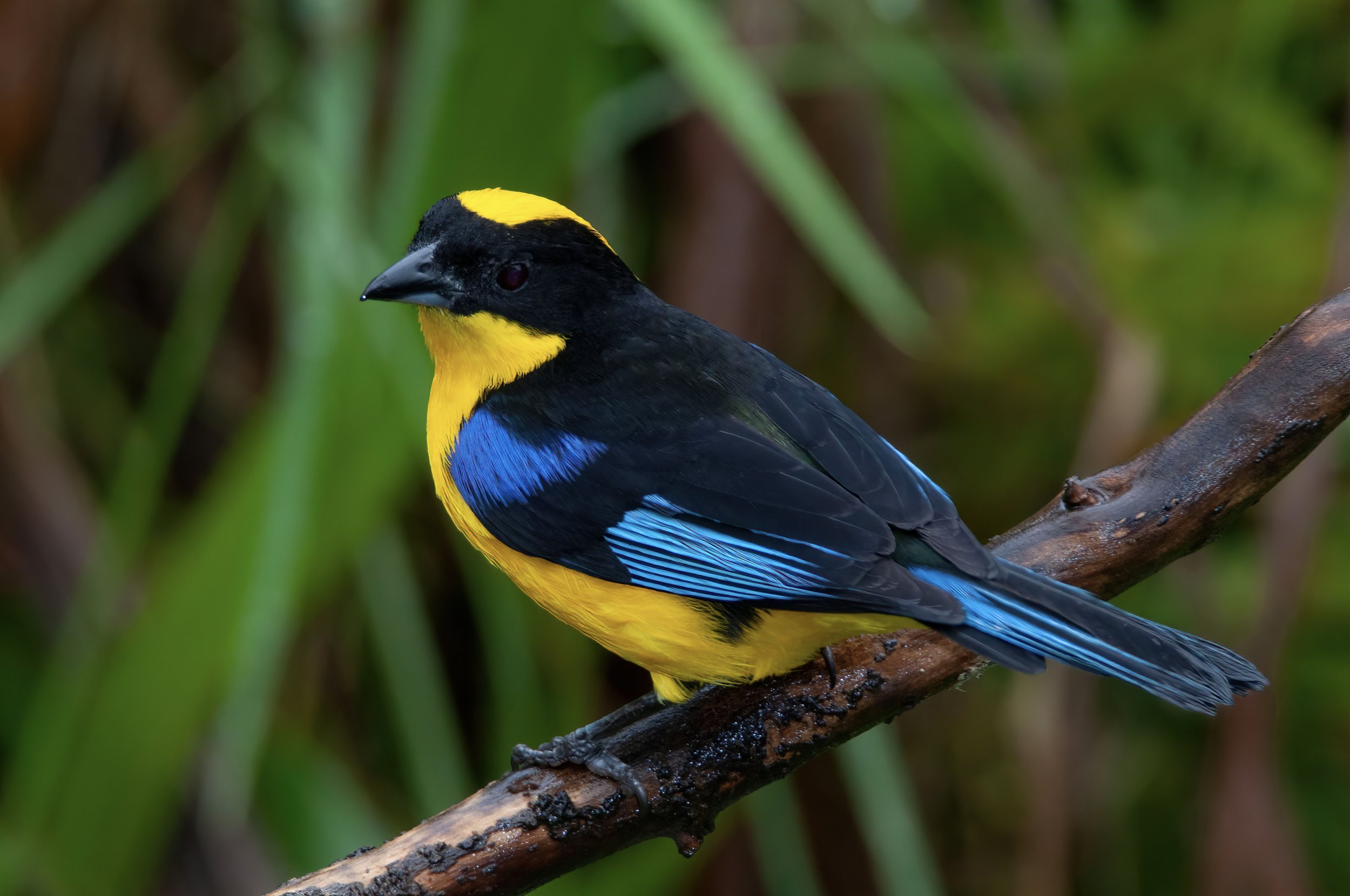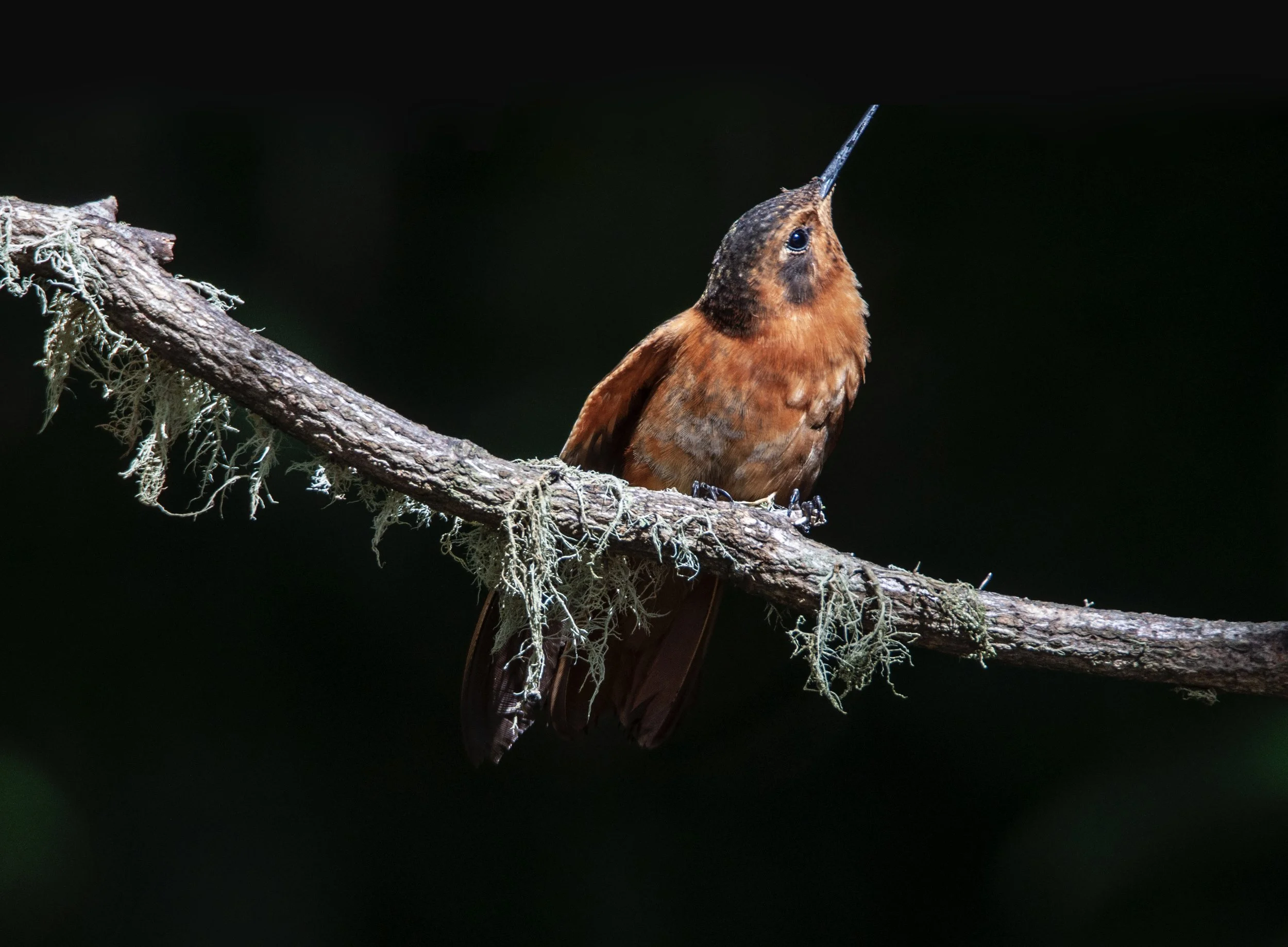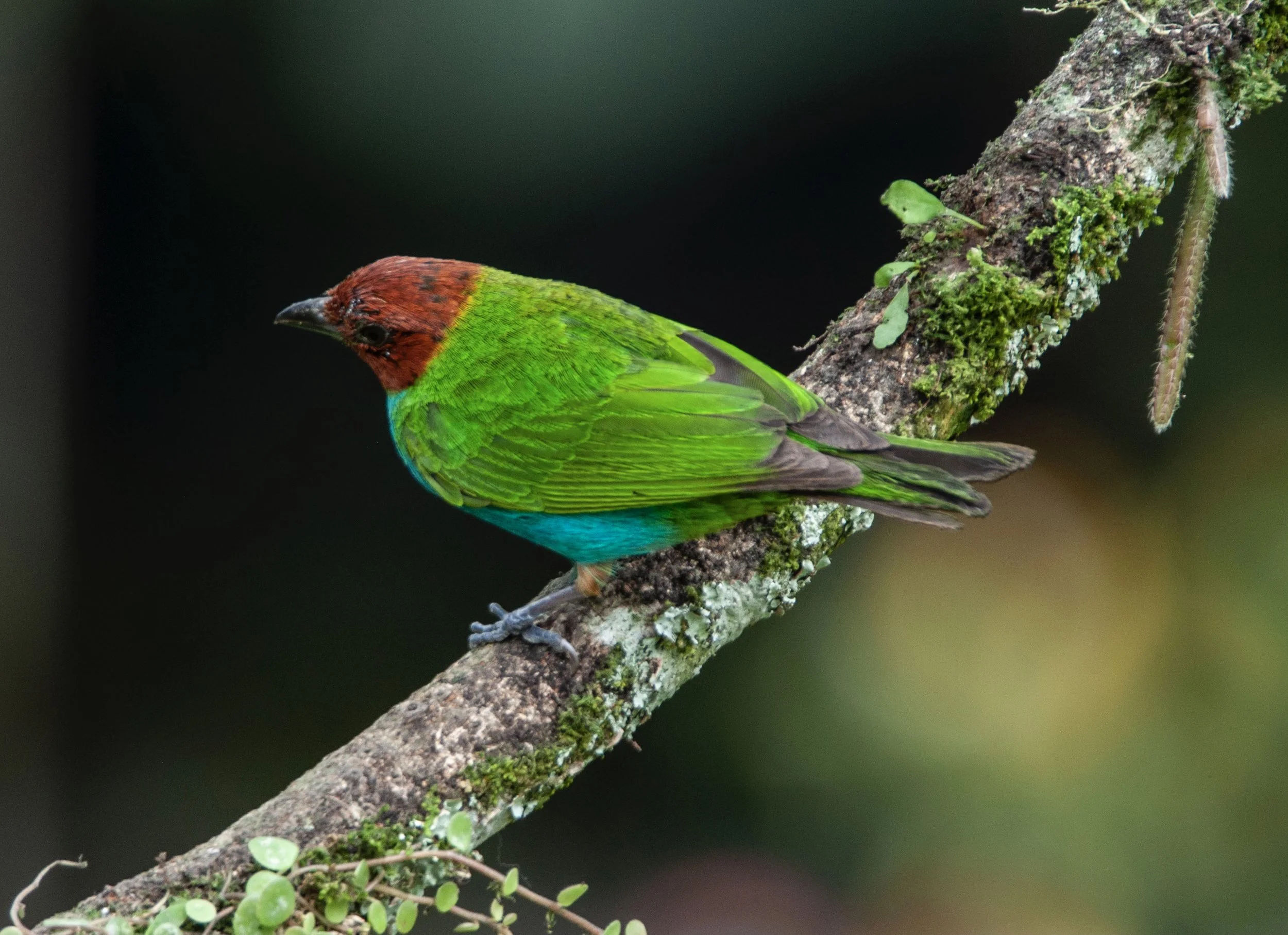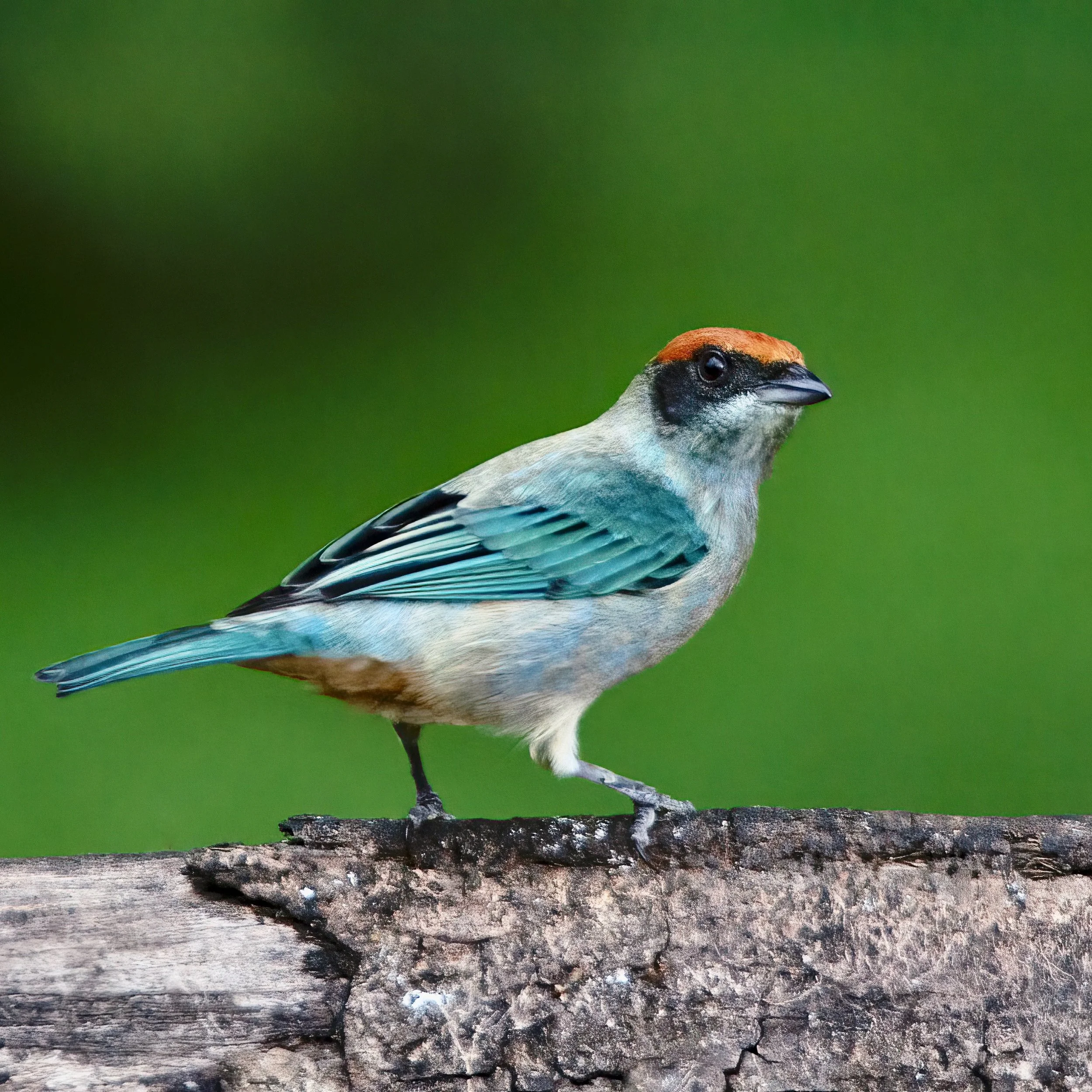The New Birding for Old Knees
Cloud forest bird watching is now not just for the super fit
by Peter Rockstroh
Male Green Honeycreeper (Chlorophanes spiza) in Caldas Department, Colombia. Image: ©Peter Rockstroh 2022
Bird watching for rarities in the tropics typically requires some personal sacrifice.
Thinking about my first birding experiences as a teenager brings back memories of very early morning wake-up calls, leaving the house in total darkness and worrying more about the thermos being filled with coffee than having the field guide in my backpack. We always seemed to start traipsing around the forest in the dark; too late to see owls, too early for songbirds.
Audio luring–now controversial but viewed benignly back then–meant schlepping a heavy field tape recorder and awkward directional microphone around all day, waiting for the birds to call and start recording them in the hope that the birds would later reply to playback and approach close enough to make a species determination with certainty.
The (film) photos taken during these trips were considered prized trophies, especially if one could actually recognize what kind of bird it was lurking in the invariably blurry image. As much as I miss some of "the good old days," I am favorably impressed with many of the changes the hobby has undergone over the past decade since it shows ever greater possibilities to expand its fan base.
A few weeks ago, I organized a birding trip for three people to the Department of Caldas in western Colombia to visit some of the better-known birding spots that surround its capital, Manizales. What I mean by “better known” is that they’ve been in operation for at least a decade or of more recent vintage but very well spoken of by local and visiting birders.
On the road from Manizales to the entrance to Los Nevados National Park, on a clear day one can see all the vegetation zones from Páramo to Super Páramo and the Nival Desert. The last and highest Life Zone experiences frost almost daily. It snows regularly there, as I can attest during my recent visit. Image: ©Peter Rockstroh 2022
We stayed at Hacienda El Bosque, a relatively recently inaugurated hotel for birdwatchers, which has made quite a name for itself in a surprisingly short time. I chose it because anyone who has the guts to open a new hotel during the ongoing pandemic is either very good at what they do or very crazy.
Regardless of which it was, I was curious about all the positive buzz this private reserve was generating among local birders.
I arranged our itinerary so we could visit a different spot every day, with hopes of seeing and photographing as many different bird species as possible.
After having spent three and a half years between a wheelchair, a knee scooter and crutches due to a life-changing hiking accident in Guatemala, I was really looking forward to this birding trip. While I can now walk short distances on flat terrain pretty well, I’m still far from being able to go climbing, trekking or even walking short distances over rocky or irregular surfaces. At the outset I decided not to complain and focused on how rewarding bird-watching can be even when physical mobility is a challenge.
On the East and South African plains you have long been able to go on safari in a wheelchair if the Land Rover has been outfitted with a rail that allows you to push the chair in and out of the vehicle. But observing animals in the neotropics is a “bird-of-a-different-feather” if you will, where big sky landscapes with miles of visibility are traded for hills and mountains that spring up right in front of you it seems, all covered with dense forest mantles.
This feeding area for hummingbirds between the two houses is a simple and unobtrusive structure with many possibilities for visiting photographers. Image: ©Peter Rockstroh 2022
We arrived at Hacienda El Bosque around noon, under a slight drizzle. After lunch we were going to have a coffee–this is, after all, a major coffee producing region of Colombia–when Juan Martín, the hotel own-manager came out of the kitchen with a large basket with thermoses and a variety of baked goods.
"Let’s go birding", he said, so we followed him to the car.
We stopped about one third of a mile/500 m from the restaurant. Alongside the road was a washbasin with instructions on how to prevent COVID - the only indication that this was more than a hole in the roadside vegetation. After 10 yds/10 meters walking on a path, we arrived at a small platform overlooking a tract of forest. In front of us was a structure that resembled the goalpost of a soccer field. Behind it, across the ravine, we could see a few head of cattle grazing in a distant meadow.
"Please have a seat", a young guide said to us. He was wearing rubber boots and was dressed like a park ranger, and even behind his face mask we could see a big smile. "Take out your cameras and set up your gear and let me know when you are ready".
Being known for being occasionally a little dense I asked, "Ready for what?"
"Well, for photographing the birds of course", he replied.
I looked around and thought "What birds? Cattle egrets? Anis? This is also a working dairy farm at nearly 4,000 meters (= 13,000’) above sea level".
I could still sense him smiling under his mask when he turned around and called loudly into the ravine, "Ambrosio! ¡Ambroooosio! ¿Ambro? ¡Ambroooosio!
Not even two minutes later I heard wings flapping, then Señor Ambrosio was suddenly perched on the crossbar of the goalpost and sat there looking around, almost as if he was bored. Ambrosio is a Gray-breasted Mountain Toucan (Andigena hypoglauca), one of the nearly two dozen species of toucans occurring in Colombia. It is one of the most colorful members of this family and more often seen than heard. I had tried photographing this toucan elsewhere using brief snippets of playback but had never had any luck before.
Ambrosio, Hacienda El Bosque’s Gray-breasted Mountain Toucan mascot and a neighbor sparring for grapes. Image: ©Peter Rockstroh 2022
After a few minutes of inactivity, another Mountain Toucan joined him on the perch, and they began playing and mock fighting. As I looked around me, everybody had their cameras out and was chatting and photographing these two birds, who seemed to be totally oblivious to what was happening on the viewing platform.
The toucans were calling so loudly that Juan Martín had to holler above the group’s noise level, "Who wants coffee?"
This was something else. This was not the typical whisper-voiced, tip-toeing kind of birding, where one uses discreet hand signs rather than one’s voice to ask for a coffee. This was like bird watching while having lunch with a rowdy and very funny Italian family. These fully wild birds had been completely habituated to human presence without being treated like pets.
I sat down on a very comfortable chair, sipping good coffee and photographing these gorgeous toucans. Within half an hour, another five or six bird species had taken up temporary residence on the perches surrounding the platform. None were bothered by loud comments or laughter. We had more sweet rolls and more coffee, and two hours later we returned to our rooms with many fine images of fantastic birds.
The usually shy Hooded Mountain Tanager (Buthraupis montana) also loves grapes, and loses its timid behavior when at the feeder. Image: ©Peter Rockstroh 2022
It was getting very chilly, so we decided to go birding to a different place the next day, at the very least a bit warmer than where we were. The next morning, we drove to Tinamu Birding, a traditional birding area established around an old shade-grown coffee plantation. Since I couldn’t walk the trails, I stayed at the farmhouse at the entrance to the reserve while the others hiked out.
I put my camera on a tripod and was ushered to a large, plush sofa right in front of a bird feeder. Within the first ten minutes, half a dozen incredibly colorful tanagers arrived. While Blue-gray Tanagers (Thraupis episcopus) outnumbered the rest, there were always splashes of other more intense colors at this feeder.
Both Sickle-winged (Chamaepetes goudotii - shown above) and Andean Guans (Penelope montagnii) are lured to visit feeders when they see more birds in the area. Image: ©Peter Rockstroh 2022
“I was extremely pleased with my photos from this session. They looked–I can’t think of a better word–’professional’. ”
Male and female Summer Tanagers (Piranga rubra) arrived separately, alternating with Bay-headed tanagers (Tangara gyrola) and Green Honeycreepers (Chlorophanes spiza). Various species of montane robins would occasionally stir up things, then a pair of hungry guans (Penelope species) would raid the feeder, swallowing half a banana in one gulp.
Summer tanagers (Piranga rubra) are a common sight in the region. A handsome male is shown here. Image: ©Peter Rockstroh 2022
I was extremely pleased with my photos from this session. They looked–I can’t think of a better word–professional. Whoever had built the feeder had paid a lot of attention to detail. The light was perfect; no distracting elements in the close background, no visible banana peels, nor cans with rotting fruit with flies buzzing around them.
"It’s a nice bokeh", one of the resident bird guides said, as he walked towards me. I knew what he meant. He was talking about the out-of-focus background behind the feeder, that makes the birds stand out when photographed.
“Bokeh” refers to the quality of the out-of-focus areas in the background and is frequently used as a measure of lens quality. Regardless of how the word was used, the effect was obvious.
Above, aptly-named Blue-winged Mountain Tanagers (Anisognathus somptuosus) are seasonally abundant throughout the western highlands of Colombia at middle elevations. They usually move in small groups at the edge of clearings and are common visitors at Miguel’s feeders. Images: ©Peter Rockstroh 2022
A key issue that was obvious at all these lodges is the importance of properly siting perches for photographers. The guides have learned to spend a lot of time looking for the perfect branches, filling them with epiphytes and other floral knick-knacks. Interesting shapes and textures, native bromeliads, orchids and lianas were placed strategically close to the feeders, where the birds could perch before moving towards the food. At another birding spot, Río Blanco, our guide Miguel filled a hollow branch with bananas and carefully covered it in moss. Not only does the perch look realistic but it also keeps the birds busy trying to extract the bananas, making it much easier to photograph them.
Miguel, our guide, feeding on bananas at one of the perches. Just kidding! Miguel is shown carefully preparing a perch to lure local birds, stuffing banana into the hollow branch and wrapping it with tree moss to camouflage the feeder. Image: ©Peter Rockstroh 2022.
The whole ensemble of factors taken into account to set up feeders for birds makes the visit very efficient and satisfactory for everyone. Those who can walk the trails get to see fantastic birds in gorgeous areas of forest, and those who can’t get to see fantastic birds in beautiful settings, from the comfort of a chair or a sofa.
On the third day we drove up the road to see the snow-capped volcano Nevado del Ruíz, whose last violent eruption in 1985 destroyed the town of Armero. Although the peak is often completely covered in clouds, the volcano was perfectly visible as we drove up to the parks’s entrance. Apart from visiting the park, I wanted to see a bird that has a very small distribution range: the Bearded Helmetcrest (Oxypogon guerinii). This short-billed hummingbird occurs in patches of páramo and super páramo in this park, between 11,500-16,250’/3,500 - 5,000 meters elevation. The distribution area of a bird doesn’t get much more localized than this.
A simple textured branch placed underneath a dark canopy with holes provides a perfect setting for avian portraits. Image: ©Peter Rockstroh 2022
Shining Sunbeam Hummingbird (Aglaeactis cupripennis). Image: ©Peter Rockstroh 2022
We sat down on the terrace of the park’s entrance, sipping coca tea, overlooking a patch of páramo brush, when–lo and behold–a female Helmetcrest flew by and dropped to the ground at our feet, looking for insects in the shrub. If I were a hardcore birder, I could have ticked off a Lifer from my checklist.
Colombia understood a long time ago that páramo areas are water factories, and placed these water catchments under protection about 40-50 years ago. This also helped to avoid the deforestation and erosion of most of these invaluable water sources. While there are still hotspots where the agricultural frontier collides with national park management, today most people in Colombia understand the need to protect these watersheds.
To see that firsthand, on our last day we visited Río Blanco, the reserve that the water company of Manizales is protecting as a source of the town’s water supply. Purchased as a clear-cut property in 1902, the area today has a mature secondary forest with a 100-foot canopy and several layers of undergrowth. We drove up slowly on a well-kept dirt road and stopped after about a third of a mile/500 meters. Miguel, our bilingual guide, got out of the car and pulled a can of earthworms out of the pocket of his field jacket. He pointed at a patch of fallen leaves between two trees and signaled us to point our cameras at this spot.
Blue-necked Tanager (Stilpnia cyanocollis), one of the poster children of Colombian cloud forest birding. Image: ©Peter Rockstroh 2022
Not knowing if we were going to see a rare shrew or Bigfoot’s toe, I asked quietly, "What are we looking for?".
Chestnut-crowned Antpitta, Grallaria ruficapilla, at the Río Blanco Reserve. Image: ©Peter Rockstroh 2022
He replied, "Antpittas", as if there was no other reasonable thing to be waiting on.
Their three-note call is often described as com-pra-pan (= Buy bread) or the phonetical to-ro-roi, which is what they are called locally. Until 2014, antpittas were rarely photographed, because of their secretive habits. That year, a bird guide from Ecuador named Angel Paz decided to conduct an experiment and became the first Pitta Whisperer. With astonishing patience and consistency, he called and fed an antpitta worms and beetle larvae for six months, until he got her to come out of the shrubbery when called and take the juicy morsels from his hand. The following year Angel taught a few guides in Colombia how it was done, and today there are several places where these shy birds are called to feeding stations, so everyone can see and enjoy them.
It takes a lot of dedication to habituate wild birds to human presence, especially if you expect them to be exposed to many people, noise and movement. Miguel took half a worm out of his can and tossed it at the spot between the trees. Instead of a playback of the pitta’s call or an imitation, he started calling, "Juaaancho! Juaaanchooo! Juaaaanchoooo !" It took about ten minutes and I was about to leave, when a beautiful Chestnut-crowned Antpitta (Grallaria ruficapilla) stepped into the small clearing. This male helped himself to the worm Miguel offered but waited for a few more before returning to the nest to feed its young. He stayed with us until he had no more space in his beak for more worms.
"I came here every morning for seven months, carrying earthworms and grubs. They just love them", Miguel told us. Most of these birds respond only to the call of the guide that "trained" them. Nestor, the guide working at Hacienda El Bosque, also spent over half a year getting his troop of followers to come when he calls them. They include a pair of Mountain Toucans, a pair of Sickle-winged Guans, a Hooded Mountain Tanager, Barred Fruit Eaters and his favorite, Lunita, a Spotted Antpitta he has been feeding for several years.
"What is the trick?", I asked Juan Martín and Nestor. "How do you get them to stay in the long run?"
"We have a thousand US dollar monthly bill for grapes", he replied.
“All these techniques are designed to benefit birders and nature photographers, and they were implemented with the purpose of bringing the birds closer and making it easier to photograph them. But the way it is being done also allows people with limited mobility and other physical challenges to see colorful exotic birds up close and enjoy them.”
My wife Maria José enjoying the company of Shining Sunbeam Hummingbird (Aglaeactis cupripennis) at Termales del Ruíz. Image: ©Peter Rockstroh 2022
O.K. So, I guess these birds must really love grapes. The other birding spots we visited consume between one and two tons (yes, I mean between 2,200 and 4,400 pounds!) of bananas per month just to attract birds.
It seems to be paying off. Especially considering that people from this region are called Paisas, which in Colombia is synonymous with being very business-savvy. It is also associated with rural hospitality in this country. I was very pleased to see that all these issues added up to a long list of factors that make birding accessible and easier for people with severely limited mobility. I certainly benefited from these design features.
All these techniques are designed to benefit birders and nature photographers, and they were implemented with the purpose of bringing the birds closer and making it easier to photograph them. But the way it is being done also allows people with limited mobility and other physical challenges to see colorful exotic birds up close and enjoy them. The places we visited required only minor changes to make them accessible to wheelchairs and thus be fully “friendly” to more disabled persons.
Bay-headed Tanager (Tangara gyrola). Image: ©Peter Rockstroh 2022
It won’t take long for the local birding-oriented tourism services to realize the large addressable market they have if they can organize their tours with these clients in mind, especially as even late baby boomers become creaky senior citizens with lessened mobility. There are few if any businesses catering to this market segment in Latin America.
But I can personally confirm that there’s no audience more grateful for these efforts on their behalf.
Ambrosio looking on. Image: ©Peter Rockstroh
I would like to thank Juan Martín, the guides and all the staff at Hacienda El Bosque for their hospitality and constant support. Many thanks also to Rodrígo Cortés, for always having us on time wherever we wanted to be, and the other people we met in Caldas, Colombia, who so proudly shared their knowledge of this spectacular region with us.
Andean Guan (Penelope montagnii) at one of Hacienda El Bosque’s feeding stations. Image: ©Peter Rockstroh 2022
All content ©Exotica Esoterica® 2022 and ©Peter Rockstroh 2022
Follow us on:
